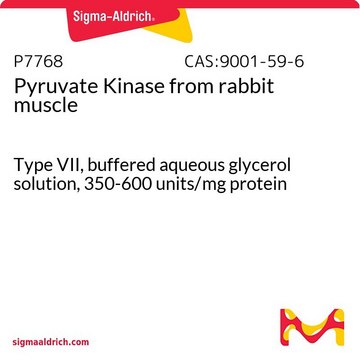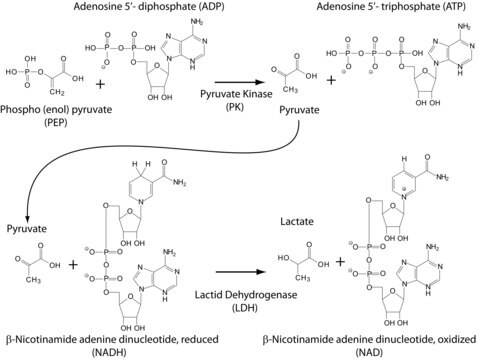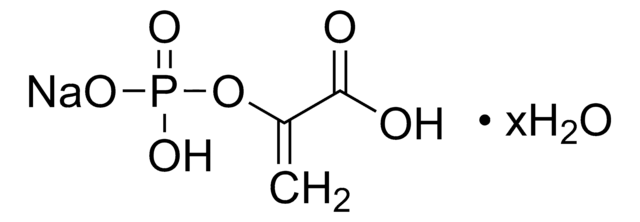P1903
Pyruvat-Kinase aus Bacillus stearothermophilus
Type VIII, lyophilized powder, 100-300 units/mg protein
Synonym(e):
ATP:pyruvate 2-O-phosphotransferase
About This Item
Empfohlene Produkte
Biologische Quelle
Bacillus sp. (B. stearothermophilus)
Qualitätsniveau
Typ
Type VIII
Form
lyophilized powder
Spezifische Aktivität
100-300 units/mg protein
Lagertemp.
2-8°C
Allgemeine Beschreibung
Mammalian pyruvate kinase is a tetrameric protein composed of identical subunits organized in a dimer-of-dimers configuration. Four isoforms of pyruvate kinase exist in mammals, namely PKM1, PKM2, PKR, and PKL. Pyruvate kinase can be found in both tetrameric and dimeric forms.
Anwendung
Biochem./physiol. Wirkung
Pyruvate kinase is a key regulator controlling metabolic flux and ATP production in glycolysis and is considered a potential drug target. Additionally, pyruvate kinases are subject to regulation by heterotropic effectors, with fructose 1,6-bisphosphate (FBP) being the most widely known allosteric activator of bacterial, yeast, and mammalian enzymes. Furthermore, PKM2, one of the four isoforms of pyruvate kinase, is extensively expressed in various types of tumors and is associated with tumorigenesis.
Einheitendefinition
Physikalische Form
Hinweis zur Analyse
Lagerklassenschlüssel
11 - Combustible Solids
WGK
WGK 3
Flammpunkt (°F)
Not applicable
Flammpunkt (°C)
Not applicable
Persönliche Schutzausrüstung
Eyeshields, Gloves, type N95 (US)
Analysenzertifikate (COA)
Suchen Sie nach Analysenzertifikate (COA), indem Sie die Lot-/Chargennummer des Produkts eingeben. Lot- und Chargennummern sind auf dem Produktetikett hinter den Wörtern ‘Lot’ oder ‘Batch’ (Lot oder Charge) zu finden.
Besitzen Sie dieses Produkt bereits?
In der Dokumentenbibliothek finden Sie die Dokumentation zu den Produkten, die Sie kürzlich erworben haben.
Kunden haben sich ebenfalls angesehen
Unser Team von Wissenschaftlern verfügt über Erfahrung in allen Forschungsbereichen einschließlich Life Science, Materialwissenschaften, chemischer Synthese, Chromatographie, Analytik und vielen mehr..
Setzen Sie sich mit dem technischen Dienst in Verbindung.












